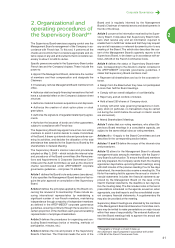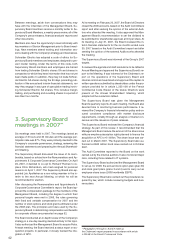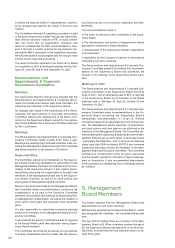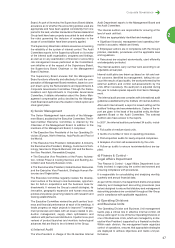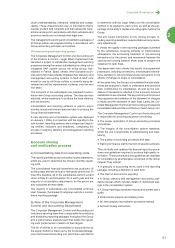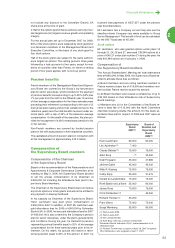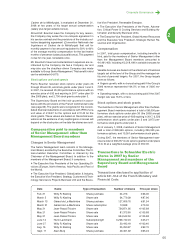APC 2007 Annual Report Download - page 52
Download and view the complete annual report
Please find page 52 of the 2007 APC annual report below. You can navigate through the pages in the report by either clicking on the pages listed below, or by using the keyword search tool below to find specific information within the annual report.50
The carrying value of trademarks is determined based on
an assessment of the economic value of the underlying
business at the time of acquisition and, for the most signif-
icant, on an independent valuation of the trademark.
Contractual customer relationships are recognized in cer-
tain business combinations, based on independent valua-
tions.
In accordance with IFRS, goodwill and non-amortizable in-
tangible assets recognized in business combinations are
tested yearly (and sooner if there is an indication of im-
pairment) to ensure that the recoverable amount is higher
than the carrying amount.
Property, plant and equipment
Land and buildings are tracked by the Property department
and stated at historical cost net of accumulated deprecia-
tion and any accumulated impairment losses. Manufactur-
ing assets are tracked by the Globalization & Industry
department.
Property, plant and equipment are recognized in the ac-
counts on the basis of title deeds, an invoice or a finance
lease accompanied by documentary evidence that the
asset has been put into service.
Equity investments
Investments in consolidated companies and available-for-
sale financial assets are tracked and verified by the Fi-
nance & Control – Legal Affairs Department.
Inventories
Inventories are verified at least once a year in each sub-
sidiary through physical inventories or cycle counts. In-
ventories are written down to net realizable value where
appropriate.
Customers
When sales are recorded in the accounts by the sub-
sidiaries, this automatically generates an entry in a trade
receivables account. Receivables are valued and–where
appropriate–written down by the subsidiaries in accor-
dance with Group policies. A credit management charter
prepared by the Customer Credit Department provides
guidelines for new customer acceptance, credit limits,
credit insurance, dunning and recovery procedures.
Tax assets and liabilities
The subsidiaries are responsible for calculating, accruing
and managing their taxes, except in those cases where the
subsidiary concerned is a member of a tax group.
The Tax unit within the Finance & Control - Legal Affairs
Department reviews the current tax charge in countries
that represent a significant portion of the Group’s total tax
charge. The Tax unit is also responsible for overseeing the
resolution of tax claims.
The Operating Divisions generally have their own tax de-
partments, which ensure compliance with local regulations.
The Statutory and Management Accounting unit within the
Finance & Control – Legal Affairs Department reviews the
Group’s current and deferred tax position during each
quarterly consolidation process. The procedure includes
performing analytical reviews of the main subsidiaries’ tax
position, preparing the tax proof validating the Group's ef-
fective tax rate, and analyzing changes in deferred tax as-
sets and liabilities by category of tax basis.
Provisions for contingencies
Group policy consists of recording provisions for contin-
gencies and charges in the accounts of the individual sub-
sidiaries. Claims and litigation are generally managed
jointly by the subsidiary and the Finance & Control - Legal
Affairs Department. Provisions for contingencies are ad-
justed to reflect any changes in the estimated risk. Move-
ments recorded by subsidiaries are required to be
evidenced and are checked for compliance with the appli-
cable accounting standards. When necessary, the Group
uses independent experts to assess risks.
Employee benefits
The subsidiaries are responsible for managing their em-
ployee benefit obligations under compulsory and company-
sponsored plans. Group policy consists of systematically
recording provisions for statutory length-of-service awards
due to employees on retirement, pensions and healthcare
costs paid on behalf of retired employees in all countries
where the Group has an obligation under the related plans.
Long- and short-term debt
Net debt is managed at Group level by the Finance & Con-
trol - Legal Affairs Department. Where appropriate, cash
pooling agreements and currency position management
agreements are set up to profit from economies of scale
and minimize financing costs.
Decisions concerning the financing of subsidiaries are
made by the Finance & Control - Legal Affairs Department.
The bulk of their financing needs are met by short-term in-
tercompany loans in their functional currency, but in some
cases the Corporate Treasury Center may decide to ob-
tain external financing. Long-term debt is managed at
Group level.
Bond issues are submitted to the Supervisory Board for
approval.
Off-balance sheet commitments
The off-balance sheet commitments of newly-acquired
subsidiaries are reviewed and analyzed when the com-
pany joins the Group. Financial guarantees are issued by
the Finance & Control – Legal Affairs Department.A con-
solidated statement of off-balance sheet commitments is
produced at six-month intervals by the Corporate Man-
agement Control and Accounting unit, which performs an-
alytical reviews to check the data. Other legal commitments
are tracked by the Legal Affairs unit.
Procedures for the production
of accounting
and financial information
System design, database
and accounting standards
The Group has prepared its financial statements in accor-
dance with International Financial Reporting Standards
(IFRS) since January 1, 2005.
The Group applies the IFRSs adopted by the European
Union as of December 31, 2007. The Group’s accounting
principles reflect the underlying assumptions and qualita-
tive characteristics identified in the IFRS accounting frame-
work. This involves preparing the financial statements on
the accrual basis of accounting and assuming that the
business is a going concern. Qualitative characteristics in-



